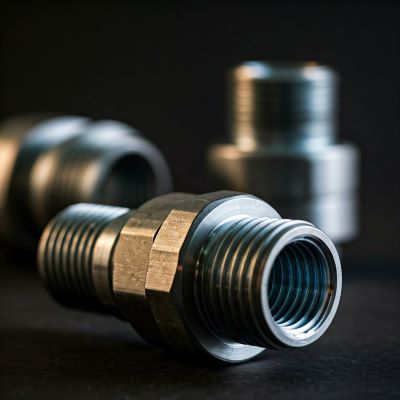Threads are an essential component of many mechanical and plumbing applications, providing a secure and reliable connection between different parts. Understanding the different types of threads available is crucial for selecting the right one for your specific needs.
What is a G Thread?
G threads are a type of parallel thread that is commonly used in plumbing and hydraulic applications. They are also known as Whitworth threads or British Standard Pipe Taper (BSPT) threads. G threads are characterized by their triangular profile and their coarse pitch.
G threads are typically used in applications where a tight seal is required, such as in plumbing fixtures and hydraulic fittings. They are also a popular choice for applications where the threads are subject to high pressure or vibration.
The most common thread types used across industries include:
➡️ G threads
➡️ BSP (British Standard Pipe) threads
Each thread type has its own unique characteristics and applications, so it’s important to choose the right one for your project.
Key Characteristics of Other Popular Thread Types
In addition to G threads, there are several other popular thread types used in various industries. These include:
➡️ NPT (National Pipe Thread): NPT threads are tapered threads that are commonly used in North America for plumbing and gas pipe applications. They are known for their ability to create a tight seal, even under high pressure.
➡️ BSP (British Standard Pipe) threads: BSP threads are parallel threads that are commonly used in Europe and other parts of the world. They come in two varieties: British Standard Pipe Taper (BSPT) and British Standard Pipe Parallel (BSPP). BSPP threads are used for applications where a loose fit is required, while BSPT threads are used for applications where a tight seal is needed.
➡️ UNC and UNF threads: UNC (Unified National Coarse) and UNF (Unified National Fine) threads are general-purpose threads that are commonly used in mechanical engineering. They are available in a variety of sizes and pitches, making them suitable for a wide range of applications.
➡️ Metric threads: Metric threads are a type of parallel thread that is based on the metric system. They are widely used in Europe and other parts of the world, and are becoming increasingly popular in North America.
G Thread vs NPT: Key Differences
G threads and NPT threads are two of the most common thread types used in plumbing and hydraulic applications. Nonetheless, there are a few significant distinctions between the two.
One of the main differences between G threads and NPT threads is their sealing method. G threads rely on a sealant, such as PTFE tape or pipe dope, to create a tight seal. NPT threads, on the other hand, rely on the taper of the threads to create a seal.
Another key difference between G threads and NPT threads is their performance in high-pressure and high-temperature environments. G threads are typically more resistant to high pressure and high temperatures than NPT threads.
G Thread vs BSP: A Detailed Breakdown
G threads and BSP threads are both parallel threads that are commonly used in plumbing and hydraulic applications. There are a few significant distinctions between the two, though.
One of the main differences between G threads and BSP threads is their thread design. G threads have a triangular profile, while BSP threads have a trapezoidal profile.
Another key difference between G threads and BSP threads is their pitch. G threads have a coarser pitch than BSP threads.
Finally, G threads and BSP threads are not compatible with each other. This means that you cannot use a G thread fitting with a BSP thread fitting, and vice versa.
Choosing the Right Thread for Your Needs
When choosing a thread type for your project, there are several factors to consider. These include:
➡️ Pressure requirements: The thread type you choose should be able to withstand the pressure requirements of your application.
➡️ Sealing preferences: Some thread types, such as NPT threads, rely on the taper of the threads to create a seal. Other thread types, such as G threads, require a sealant.
➡️ Material compatibility: The thread type you choose should be compatible with the materials that will be used in your application.
Tools and Techniques for Thread Identification
There are a number of tools and techniques that you can use to identify thread types. These include:
➡️ Thread gauges: Thread gauges are used to measure the diameter and pitch of a thread.
➡️ Micrometers: Micrometers can be used to measure the diameter of a thread.
➡️ Telescoping gauges: Telescoping gauges can be used to measure the depth of a thread.
Advantages and Limitations of G Threads
G threads have a number of advantages over other thread types. These include:
➡️ Precision: G threads are very precise, which makes them ideal for applications where a tight seal is required.
➡️ Durability: G threads are very durable, which makes them suitable for use in high-pressure and high-temperature applications.
However, G threads also have some limitations. One of the main limitations of G threads is that they require a sealant to create a tight seal. In certain situations, this might be a drawback.
Conclusion
G threads are a versatile and reliable thread type that is commonly used in plumbing and hydraulic applications. However, it is important to choose the right thread type for your specific needs. By understanding the different thread types available and their characteristics, you can make an informed decision about which thread type is best for your project.
Final tips for ensuring optimal performance and reliability with thread choices:
➡️ Always use the correct tools and techniques when working with threads.
➡️ Make sure that the threads are clean and free of debris before assembly.
➡️ Use a sealant, such as PTFE tape or pipe dope, when necessary.
➡️ Tighten the threads to the manufacturer’s specifications.
Post time: Jan-08-2025


